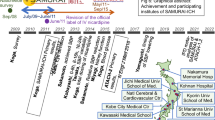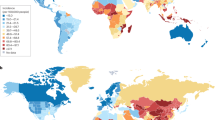Abstract
Stroke is one of the leading causes of death worldwide, and spontaneous bleeding into the brain parenchyma, intracerebral haemorrhage (ICH), is a stroke subtype associated with high morbidity and mortality. Overall, it comprises about 15% of all stroke in Caucasians, this figure being much higher in Asians and black people. Blood pressure (BP) appears to play an important role in this disease. We have reviewed available literature on the relationship of BP to the occurrence of primary and secondary ICH, the association of BP levels measured early after stroke with prognosis and complications, and evidence about the effects of early BP lowering treatments on post-stroke outcomes. BP appears to be an important risk factor for primary and secondary ICH. In addition, high BP early after ICH may be detrimental to outcome, possibly contributing to complications such as rebleeding and haematoma enlargement. Few data are available about the effects of early lowering of BP on outcome after ICH with no reliable trial yet conducted. Proper randomised trials are required to establish the effect of early lowering of BP on outcome after ICH.
This is a preview of subscription content, access via your institution
Access options
Subscribe to this journal
Receive 12 digital issues and online access to articles
$119.00 per year
only $9.92 per issue
Buy this article
- Purchase on Springer Link
- Instant access to full article PDF
Prices may be subject to local taxes which are calculated during checkout


Similar content being viewed by others
References
Broderick J et al. Intracerebral hemorrhage is more than twice as common as subarachnoid haemorrhage. J Neurosurg 1993; 78: 188–191.
Anderson CS, Jamrozik KD, Broadhurst RJ, Stewart-Wynne EG . Predicting survival for 1 year among different subtypes of stroke: results from the Perth Community Stroke Group. Stroke 1994; 25: 1935–1944.
Qureshi A, Tuhrim S, Broderick J . Medical progress: spontaneous intracerebral hemorrhage. N Eng J Med 2001; 344: 1450–1460.
Jaya F et al. Stroke patterns in northeast Malaysia: a hospital based prospective study. Neuroepidemiology 2002; 21: 28–35.
Hung T, Chen S . Cerebral hemorrhage in Taiwan. J Formos Med Assoc 1993; 92(Suppl 4): S161–S168.
Suzuki K et al. Stroke incidence and case fatality in Finland and in Akita, Japan: a comparative study. Neuroepidemiology 1994; 13: 236–244.
Tanaka H et al. Risk factors for cerebral hemorrhage and cerebral infarction in a Japanese rural community. Stroke 1982; 13: 62–73.
Ong TZ, Raymond AA . Risk factors for stroke and predictors of one month mortality. Singapore Med J 2002; 43: 517–521.
Eastern Stroke and Coronary Heart Disease Collaborative Research Group. Blood pressure, cholesterol, and stroke in eastern Asia. Lancet 1998; 352: 1801–1807.
Woo D et al. Genetic and environmental risk factors for intracerebral hemorrhage. Preliminary results of a population based study. Stroke 2002; 33: 1190–1196.
Broderick J et al. Guidelines for the management of spontaneous intracerebral hemorrhage: a statement for healthcare professionals from a special writing group of the stroke council, American Heart Association [AHA Scientific Statement]. Stroke 1999; 30: 905–915.
Dandapani B et al. Relation between blood pressure and outcome in intracerebral hemorrhage. Stroke 1995; 26: 21–24.
Tuhrim S et al. Prediction of intracerebral hemorrhage survival. Ann Neurol 1988; 24: 258–263.
Fogelholm R, Avikainen S, Murros K . Prognostic value and determinants of first day mean arterial pressure in spontaneous supratentorial intracerebral hemorrhage. Stroke 1997; 28: 1396–1400.
Tuhrim S, Dambrosia J, Price T . Intracerebral hemorrhage: external validation and extension of a model for prediction of 30 day survival. Ann Neurol 1991; 29: 658–663.
Broderick J et al. Volume of intracerebral hemorrhage. A powerful and easy to use predictor of 30 day mortality. Stroke 1993; 24: 987–993.
Terayama Y, Tanahashi N, Fukuuchi Y, Gotoh F . Prognostic value of admission blood pressure in patients with intracerebral hemorrhage: Keio cooperative stroke study. Stroke 1997; 28: 1185–1188.
Portenoy R et al. Intracerebral haemorrhage: a model for the prediction of outcome. J Neurol Neurol Psychiatry 1987; 50: 976–997.
Nath F, Nicholls D, Fraser R . Prognosis in intracerebral hemorrhage. Acta Neurochir 1983; 67: 29–35.
Lisk D et al. Early presentation of hemispheric intracerebral hemorrhage: prediction of outcome and guidelines for treatment allocation. Neurology 1994; 44: 133–139.
Daverat P, Castel J, Dartigues J, Orgogozo J . Death and functional outcome after spontaneous intracerebral hemorrhage. A prospective study of 166 cases using multivariate analysis. Stroke 1991; 22: 1–6.
Prasad K, Shrivastava A . Surgery for primary supratentorial intracerebral hemorrhage (Cochrane Review). In: The Cochrane Library, Issue 2. Update Software: Oxford, 2001.
Prentice RL et al. Serial blood pressure measurements and cardiovascular disease in a Japanese cohort. Am J Epidemiol 1982; 116: 1–28.
Arakawa S et al. Blood pressure control and recurrence of hypertensive brain hemorrhage. Stroke 1998; 29: 1806–1809.
Perry H et al. Effects of treating isolated systolic hypertension on the risk of developing various types and subtypes of stroke: the Systolic Hypertension in the Elderly Program (SHEP). J Am Med Assoc 2000; 284: 465–471.
Irie K, Yamaguchi T, Minematsu K, Omae T . The J-curve phenomenon in stroke recurrence. Stroke 1993; 24: 1844–1849.
PROGRESS Collaborative Group. Randomised trial of a perindopril-based blood pressure lowering regimen among 6,105 individuals with previous stroke or transient ischaemic attack. Lancet 2001; 358: 1033–1041.
Harper G, Castleden CM, Potter JF . Factors affecting changes in blood pressure after acute stroke. Stroke 1994; 25: 1726–1729.
Wallace J, Levy L . Blood pressure after stroke. JAMA 1981; 246: 2177–2180.
Carlberg B, Asplund K, Hagg E . The prognostic value of admission blood pressure in patients with acute stroke. Stroke 1993; 24: 1372–1375.
Meyer J, Raymond B . Medical treatment of spontaneous intracranial hemorrhage by the use of hypotensive drugs. Neurology 1962; 12: 36–47.
Horn J, de Haan R, Vermeulen M, Limburg M . Very early nimodipine use in Stroke (VENUS): a randomized, double blind, placebo-controlled trial. Stroke 2001; 32: 461–465.
Brott T et al. Early hemorrhage growth in patients with intracerebral hemorrhage. Stroke 1997; 28: 1–5.
Kazui S et al. Enlargement of spontaneous intracerebral hemorrhage: incidence and time course. Stroke 1996; 27: 1783–1787.
Kazui S et al. Predisposing factors to enlargement of spontaneous intracerebral hematoma. Stroke 1997; 28: 2370–2375.
Chen S, Chen S, Hsu C, Hogan E . Progression of hypertensive intracerebral hemorrhage. Neurology 1989; 39: 1509–1514.
Broderick J et al. Ultra early evaluation of intracerebral hemorrhage. J Neurosurg 1990; 72: 195–199.
Spence J, Del Maestro R . Hypertension in acute ischemic strokes. Treat Arch Neurol 1985; 42: 1000–1002.
Hayashi M . Treatment of systemic hypertension and intracranial hypertension in cases of brain hemorrhage. Stroke 1988; 19: 314–321.
Mayer S, Sacco R, Shi T, Mohr J . Neurological deterioration in non-comatose patients with supratentorial intracerebral haemorrhage. Neurology 1994; 44: 1379–1384.
Zazulia A, Diringer M, Derdyn C, Powers W . Progression of mass effect after interacerebral hemorrhage. Stroke 1999; 30: 1167–1173.
Powers W . Acute hypertension after stroke: the scientific basic for treatment decisions. Neurology 1993; 43: 461–467.
Lavin P . Management of hypertension in patients with acute stroke. Arch Intern Med 1986; 146: 66–68.
Hirano T . No evidence of hypoxic tissue on 18 F-fluoromisonidaole PET after intracerebral hemorrhage. Neurology 1999; 53: 2179–2182.
Carhuapoma J et al. Difusion-weighted MRI and proton MR spectroscopic imaging in the study of secondary neuronal injury after intracerebral hemorrhage. Stroke 2000; 31: 726–732.
Read S et al. Identifying hypoxic tissue after acute ischemic stroke using PET and 18F-fluoromisonidazole. Neurology 1998; 51: 1617–1621.
Bhalla A, Wolfe C, Rudd A . Management of acute physiological parameters after stroke. Q J Med 2001; 94: 167–172.
Meyer J et al. Impaired neurogenic cerebrovascular control and dysautoregulation after stroke. Stroke 1973; 4: 169–186.
Strandgaard S . Autoregulation of cerebral circulation in hypertension. Acta Neurol Scand 1978; 57(Suppl 66): S1–S82.
Reilly P, Lewis S . Progress in head injury management. J Clin Neurosci 1997; 4: 9–15.
Strandgaard S, Olesen J, Skinhoj E . Autoregulation of brain circulation in severe arterial hypertension. BMJ 1973; i: 507–510.
Strandgaard S . Autoregulation of cerebral blood flow in hypertensive patients. The modifying influence of prolonged antihypertensive treatment on the tolerance to acute, drug induced hypotension. Circulation 1976; 53: 720–727.
Kaneko T, Sawada T, Niimi T . Lower limit of blood pressure in treatment of acute hypertension in intracranial hemorrhage (AHIH). J Cereb Blood Flow Metab 1983; 29(Suppl 1): S51–S52.
Kuwata N et al. Dysautoregulation in patients with hypertensive intracerebral hemorrhage. A SPECT study. Neurosurg Rev 1995; 18: 2370–2345.
Powers W et al. Autoregulation of cerebral blood flow surrounding acute (6–22 hours) intracerebral hemorrhage. Neurology 2001; 57: 18–24.
Author information
Authors and Affiliations
Corresponding author
Rights and permissions
About this article
Cite this article
Rasool, A., Rahman, A., Choudhury, S. et al. Blood pressure in acute intracerebral haemorrhage. J Hum Hypertens 18, 187–192 (2004). https://doi.org/10.1038/sj.jhh.1001647
Received:
Revised:
Accepted:
Published:
Issue Date:
DOI: https://doi.org/10.1038/sj.jhh.1001647
Keywords
This article is cited by
-
Impact of Admission Hypertension on Rates of Acute Kidney Injury in Intracerebral Hemorrhage Treated with Intensive Blood Pressure Control
Neurocritical Care (2018)
-
Drug Delivery Systems for the Treatment of Ischemic Stroke
Pharmaceutical Research (2013)



